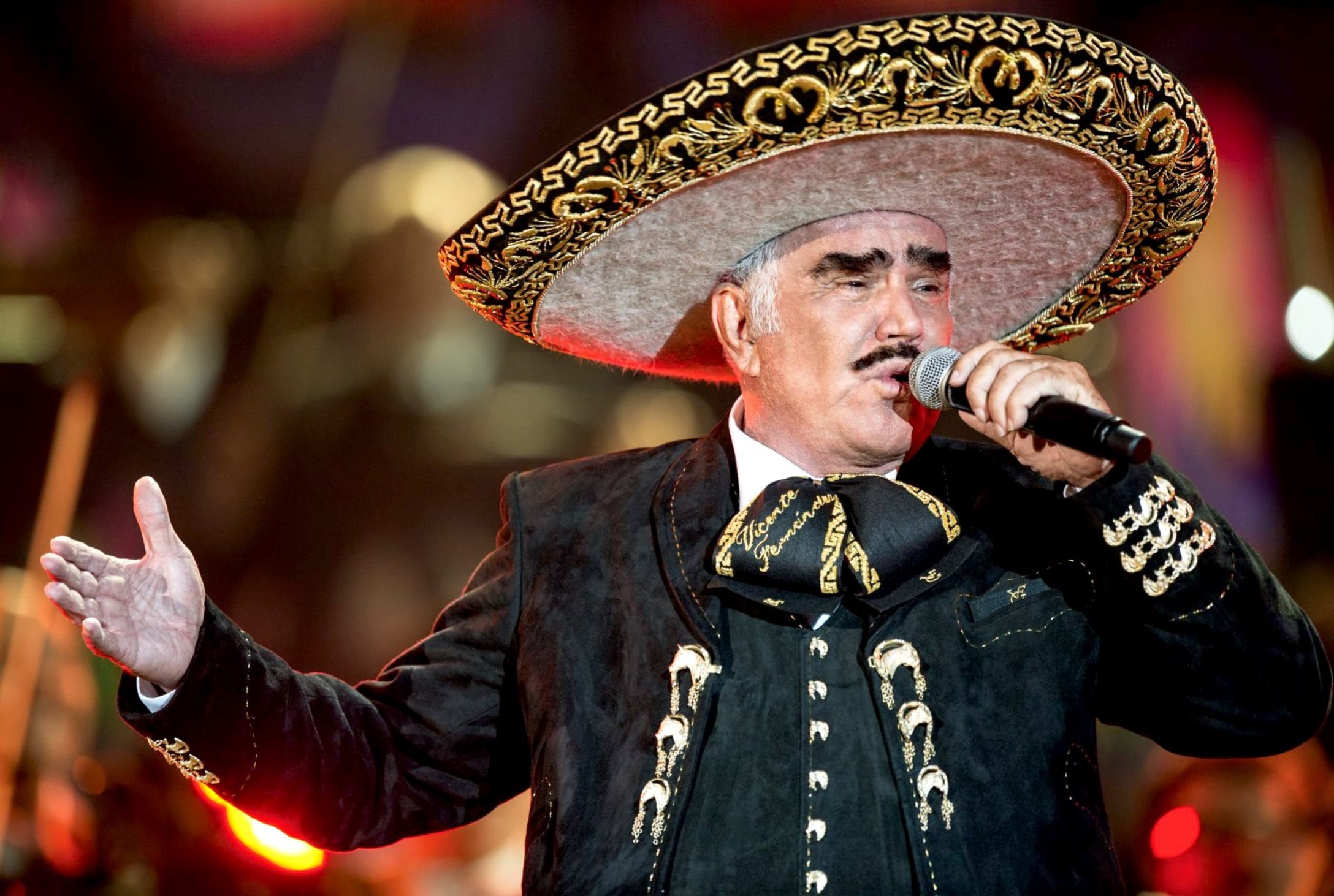
Vicente Fernández died on December 12, 2021, at the age of 81 and fans all over the world mourned the loss of an icon. It's difficult to explain to someone who has never heard of "El Rey" Vicente Fernández how much of an icon the ranchera singer is to Mexico and many Spanish-speaking people throughout the world. The man was a living legend and considered a Mexican national treasure in full charro regalia during a career that spanned six decades. Many are familiar with his voice, his songs, and his appearance, but few know the details of his life. It seems appropriate to review some of those details now as we say goodbye.
More from MamásLatinas: Famous stars we've lost this year
Personally, his death feels like losing a part of my childhood because for many of us, myself included, this man's voice was a large part of the soundtracks of our childhood. Undoubtedly his music will live on and his legend will continue to grow. His music will surely continue to be listened to and soon he will have new fans who were never even alive during his lifetime, kind of like what's happened with Selena. So, it goes with legends like Vicente "Chente" Fernández. Here is a bit of the history of "El Charro de Huentitan."
He was born on February 17, 1940.
Vicente was born in Huentitán El Alto, Jalisco, Mexico. He was born to Ramón Fernández, a rancher, and Paula Gómez de Fernández. He spent his early years on his father’s ranch.
He was inspired by Pedro Infante films.
Vicente’s mother would take him to see the films of Pedro Infante, a well-known Mexican actor and ranchera singer. "When I was 6 or 7, I would go see Pedro Infante's movies, and I would tell my mother, 'When I grow up, I'll be like him,'" Vicente once shared.
He started playing the guitar when he was 8 years old.
As a little boy, he began playing the guitar and started singing in the style of the ranchera singers that he would hear on the radio. He apparently took his vocal training into his own hands at such a young age.
He had a fifth-grade education.
He went to school until fifth grade. After his dad’s cattle business went under, the family moved to Tijuana. He told the Los Angeles Times that he took whatever kind of work he could get at the time, which included laying bricks, shining shoes, and washing dishes.
When he was 19, he won a singing competition and his career started.
During an interview, he explained that he had been singing since he was a child, but his career really started when he was 19.
"Yes, from the time I was young, but really my career started when I was 19 years old on a show called La Calandria Musical in Guadalajara," he said. "After that I would go sing at the Plaza of the Mariachis and would perform serenades for tips. Then I went to Mexico and I worked in a restaurant also singing for customers for whatever tips they wanted to give me. I left there one day when Vicente [my son] was going to be born. I left to Guadalajara and dedicated myself to cattle ranching, delivering milk in the afternoons and the morning, but one day, I felt like singing again. So I would go to the town squares around Guadalajara, and one place gave me a contract. My son was born premature at the time and with that contract I paid off the expenses of his birth. But since little Vicente was 6 1/2 months premature, we had to put him in a makeshift incubator. We placed warm water bottles around him [in a crib] and a warm light above him. So when he turned 1, I heard the news that Javier Solis had died. I recorded my first record, and then at my second record, the song, 'Palabra de Rey' became a hit. Then at the third or fourth album, came 'Volver, Volver.'"
He married María del Refugio Abarca Villaseñor in 1963.
They went on to have four children: Vicente, Gerardo, Alejandra, and Alejandro. Alejandro is also a singer; a very successful singer. He is one of the best-selling Latin music artists with over 20 million records sold.
He was a singer and a movie star.
Vicente didn’t just sing, he was also a movie star. He starred in over 30 movies throughout his career and yes, of course, he sang in his movies. It would have been a waste of his talent not to have him sing.
His concerts were epic events.
He would sing for hours and take swigs of alcohol that fans offered him. He sang rancheras in his gorgeous tenor with deep emotion and the vocal strength of an opera singer and continued to so until he was in his 70s.
He credited God for his strong and enduring voice.
He was once asked he did to maintain his ability to perform throughout so many years. “When I hear the public’s applause, I don’t know where the voice comes from, but it does for three hours. You’ll have to ask God to find out how he blesses me every time,” he replied.
He succeeded beyond his aspirations.
“When I started my career, I always had the confidence that I would one day make it, but I never imagined that I would reach the heights at which the public has placed me,” Vicente said in an interview.
His life was not without controversy.
In a 2019 interview the singer revealed that in 2012 he refused a liver transplant because the liver might come from a “homosexual or addict.” He needed a transplant because doctors had found a cancerous growth on his liver. “They wanted to give me some other man’s liver, and I told them ‘I’m not going to sleep next to my wife with another man’s liver,’” Vicente said on the show De Primera Mano. “I don’t even know if he was homosexual or an addict.”
In 2012, he had had life-saving surgery.
On November 8, 2012, at the University of Illinois Hospital & Health Sciences System he underwent a robotic left hepatectomy. The surgical procedure removed a portion of his liver which had a tumor on it. “I am very happy with my treatment — the doctors, nurses, staff, and translators — everyone has been wonderful,” Vicente said at the time.
He has a star on the Hollywood Walk of Fame.
He won many awards and in 1998 he received a star on the Hollywood Walk of Fame. His awards include three Grammys, eight Latin Grammys, and a spot in the Billboard Latin Music Hall of Fame. He was also given the keys to the city of Chicago and had a portion of a street named in his honor in 2012.
He stopped performing in 2016.
His final concert was at the Azteca Stadium in Mexico City in April 2016. There were about 85,000 people there. Some had traveled from countries far and wide to be at his last concert.
He died on a special day.
It seems significant to many that Vicente died on December 12, 2021, during the celebration of Our Lady of Guadalupe, which is a national holiday in Mexico. Vicente had sung on that day many times during the pilgrimage that many make to the Basilica of Our Lady of Guadalupe in Mexico City.
Telemundo interrupted the coverage of Virgin of Guadalupe celebrations to announce his death.
The celebration of the feast of the Virgen de Guadalupe is extremely important in Mexico. She is the patron saint of Mexico and the Americas. That Telemundo interrupted its live broadcast of Virgin of Guadalupe celebrations to announce Vicente’s death is no small thing.
He died in Guadalajara, Mexico.
He was 81 years old at the time of his death. He died in hospital in Guadalajara. His death is attributed to complications from a cervical spinal surgery he had after a fall he sustained in August.
He died on the morning of December 12, 2021.
According to a post on his official Instagram account, he died at 6:15 a.m. local time. The caption on the post translates to:
Rest in Peace Mr. Vicente Fernández.
We regret to inform you of his death on Sunday, December 12 at 6:15 am.
It was an honor and a great pride to share with everyone a great musical career and to give everything for his audience. Thank you for continuing to applaud, thank you for continuing to sing.
Alejandro posted a touching farewell.
Via Instagram, Alejandro said goodbye to his father with the following words:
The lights never shone brighter in the sky.
Without a doubt, I couldn't have asked for a better parent, friend, and teacher.
Thanks for showing me the way.
And although we will miss you every day, your spirit and voice will live forever in your family, in your town and in your people.
I love you pa ♥ ️P.S. Teach them how to put together a good palenque up there to celebrate your arrival.
Have a good trip, my dear old man.
His body was taken to his ranch in Guadalajara.
After his death was announced, his body was taken to his ranch, Los Tres Potrillos, in Guadalajara. There, fans gathered to say farewell as a mariachi played his songs. His son, Alejandro, sang “Amor de los Dos” while holding on to his mother Doña Cuquita.

